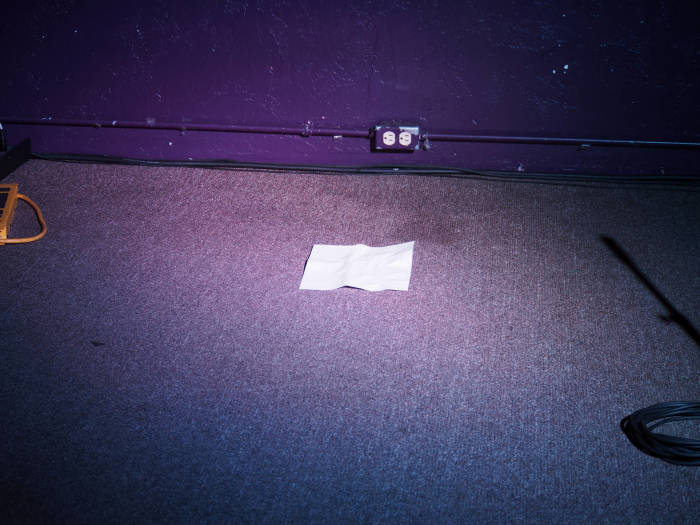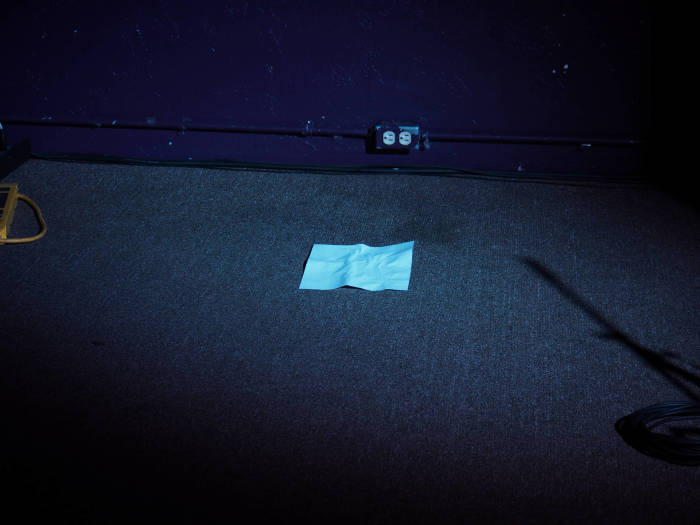They’re pretty okay, if a little “cheap.”
Please Remember:
The opinions expressed are mine only. These opinions do not necessarily reflect anybody else’s opinions. I do not own, operate, manage, or represent any band, venue, or company that I talk about, unless explicitly noted.

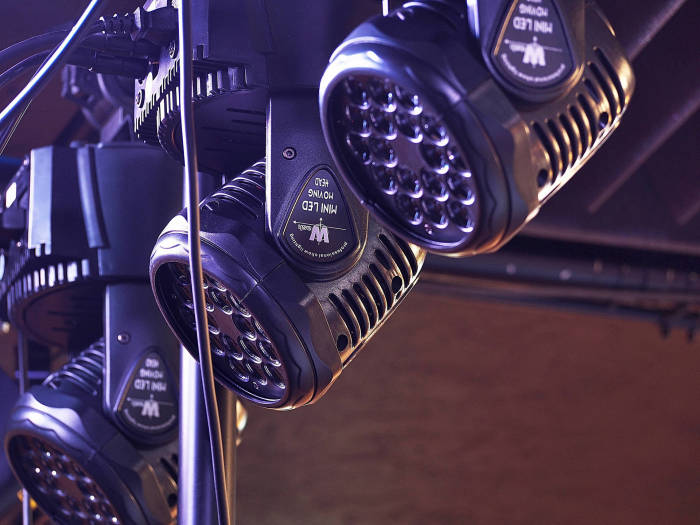 Want to use this image for something else? Great! Click it for the link to a high-res or resolution-independent version.
Want to use this image for something else? Great! Click it for the link to a high-res or resolution-independent version.If you’re a regular reader, you may remember my article about the lighting upgrade that took a lot longer than I thought it would. The main players in that upgrade were unbranded (generic, in other words) moving-head wash lights.
Unbranded lights are a way to get a lot of bang for your buck, but you do have to be cautious. The units may not be fundamentally different from what you would get from Chauvet, American DJ, Blizzard, or whoever. However, there’s also the possibility that you’re getting a variant which a factory is producing on its own. Maybe that factory used to build the units sold by the “name brands,” and then kept building lights after the line was removed from the brand’s catalog. Maybe they never built a branded unit, but got the plans and parts specs independently.
The point is that you don’t know exactly what’s going on. You also don’t know how big a part was played by the brand’s own quality control routine. It’s possible that the actual manufacturers have a high rate of “failures” or “unsatisfactories,” but end-users were unaware of the issues because the “labeled vendor” was aggressively weeding out the bad units.
If you’re going to buy generics, you need to have a tolerance for risk. If a particular factory can build and ship, say, 500 lights per month, and their failure rate is seven percent, then there are 35 chances that month for you to get a bad light. In one year, the factory might ship over 400 luminaires with a problem. That’s a lot of opportunities for a pissed-off customer to publicly say that the lights aren’t worth buying, but a seven percent rate of unsatisfactory units is probably pretty reasonable in modern manufacturing. (Notice that I said “probably.” I’m not a manufacturing process engineer. I’m a stage-production dude.)
Anyway.
The units I purchased seem to be very similar (or even fundamentally the same) as what Blizzard Lighting sold as the original Flurry Wash. All the basic specifications – from LED count and power draw to maximum pan and tilt – seem to be equivalent. Actual, Blizzard-labeled Flurry Washes seem to retail at about $350, plus or minus 15%. One of my favored vendors sells a generic version for $239. The units currently in service were purchased from DJStageLights, at a cost of only $125 per light.
The Good
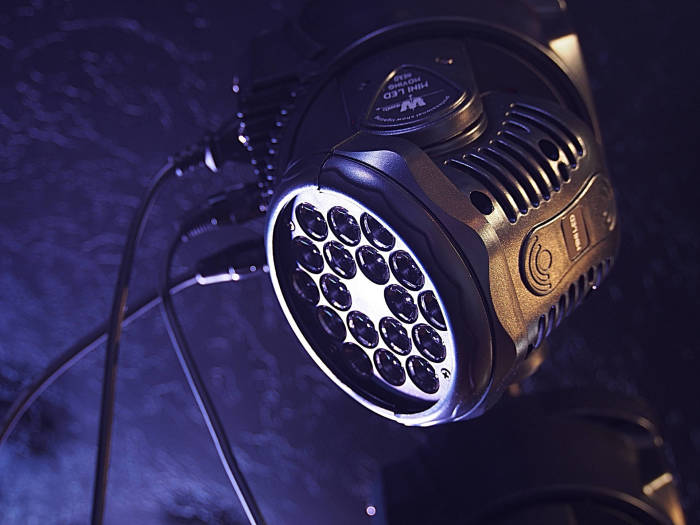 Want to use this image for something else? Great! Click it for the link to a high-res or resolution-independent version.
Want to use this image for something else? Great! Click it for the link to a high-res or resolution-independent version.A major convenience feature of the lights I bought is the control-panel. Panels of this nature display DMX addresses as decimal-notated numbers – as in, the numbers we’re used to counting with. If you want DMX address 59, then you just dial up 59 and go. You don’t have to convert from binary to decimal as you would with DIP switches, so the only thing you have to stop and think about is which address you actually want. By the same token, these displays make the setting of options easier, because the option can be displayed with a linguistic identifier. You don’t have to remember (or look up) which switch corresponds to, say, reverse tilt. You just start paging through the options, looking for something like “rTilt.”
I’m a big fan of control systems that explain themselves. It’s not that learning to count in binary isn’t a nice bit of mental exercise, it’s just that counting in binary isn’t really at the core of what constitutes competency as a lighting person.
One of my nagging fears about the lights was that they might display strange, jarring glitches in their movement. I’m pleased to say that the pan and tilt operations on these units are smooth, almost always predictable in outcome (more on that later), not subject to starting and stopping without commands, and “fast enough.” No, the heads won’t go from one positional extreme to another in the space of an eyeblink – but what do you want for $125?
In a small-venue context, the most impressive feature of these luminaires is probably their output. I’m basically quoting another staff member at my regular gig when I say, “They’ve got a pretty fair amount of firepower.” For use as an occasional special effect or show-end accent, I have some “blinder” cues written. These movers are bright enough that I consider holding the cue for more than a few seconds as being inconsiderate of the audience.
For a more objective view of the output of the lights, I decided to use my camera as a non-calibrated light meter. What I mean is that, with the camera in manual mode, I can light an area with different fixtures and compare the measured exposure values. I don’t get a lux reading, but I do get a relative reading that’s both quantitative and meaningful.
For this test, I set up one of the mini-movers to illuminate the same target area as one of my Chauvet RGBA SlimPAR 64 lights. I set things up so that the overall throw distance for each light was as similar as practicable. I shut off the other lights in the room, and then set up my camera. The exposure was set so that a picture of the target area would have an exposure value of “0.0” when the mini-mover was in use. I then kept the same camera settings, and illuminated the target area with the SlimPar. Here’s what I got:
The camera’s measurement was that the mini-mover was 1.3 stops brighter than the SlimPar, which is about two and a half times more powerful when you do the conversion. This tracks closely with the published specs for the SlimPar and the Flurry Wash, which respectively are 5300 lux and 11560 lux at one meter.
The Not As Good
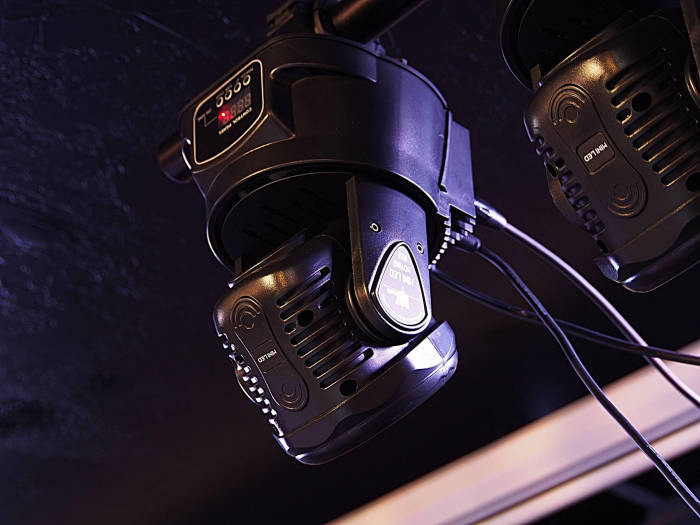 Want to use this image for something else? Great! Click it for the link to a high-res or resolution-independent version.
Want to use this image for something else? Great! Click it for the link to a high-res or resolution-independent version.There’s a certain point where a cheap light displays its cheapness. We’ve come a long way in terms of what can be accomplished at low cost, but there are still noticeable differences between units that sit on different, metaphorical shelves.
To begin at the most basic level, you need to be aware that the dimming on these units is anything but smooth. The “stepping” from brightness level to brightness level as you fade between colors and global intensities is VERY noticeable. If you must have silky-smooth fade behavior, you need to buy something else.
Another thing to keep in mind is that, while the movement on the units is overwhelmingly predictable and repeatable, not every light will be perfect at all times. If a light is run all the way to the pan or tilt “stops,” there’s a chance that it will get slightly miscalibrated. It’s not that the unit will end up pointing in a direction that’s completely wrong, it’s just that it can end up being a little off. For me, this issue has always been fixable via a fixture reset – but unfortunately, I can’t find a way to initiate that reset via a DMX command. You either have to power-cycle the light, or get up to the control panel and invoke a reset. (Be warned that invoking a reset at the panel may also set the DMX address back to the default.)
For shows like mine, an occasional position miscalibration isn’t a big problem. For other shows, it might be a dealbreaker.
As a final point, the QC on these generic luminaires seems to be a bit lacking. Getting the mounting brackets onto the light bases is a chore, because the holes for the bolts are just a touch “out of position.” You’ll eventually get the bracket attached, but you’ll probably have to resort to profanity in the process. Also, the control panels seem to be a weak link on these lights. Out of eight purchased units, I have six actually in service. This is because one of the lights has a control panel that doesn’t communicate properly with the rest of the light, and so I can’t get the lighting computer to talk to that luminaire. For the sake of symmetry, that means that I had to pull down a working unit on the other side of the stage.
Also, one of the operating units is also having minor troubles with its control panel. The problems don’t constitute a fatal error, though. (Plus, with having had to pull a working light off the line, I do have a fully functional spare.)
In a certain sense, you might say that these lights don’t actually cost $125 per piece. When you factor in the issue of having to buy more than you need (to cover the possibility of failures), each working unit will probably represent about $167.
That’s still rather inexpensive for a moving-head light, though.
If you need lights that could be used in a “varsity level” theater or arena setting, luminaires like these aren’t the right choice. However, these unbranded mini-movers are perfectly usable as serious, pro-sumer devices if you understand their limitations.
